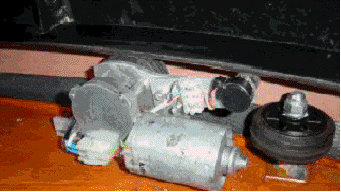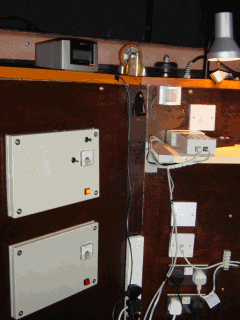I quickly discovered how often you need to rotate the dome to keep up with the telescope as it tracks an object. This meant staying in the observatory during long exposures. Pushing the dome around by hand just seems like a drag!
So I decided to add a power drive and synchronise it to the telescope controller. There are three main tasks to be tackled - first the motor drives, then the servo, and finally the software to link with the telescope control program.
This may all seem like a bit of a luxury, well it is - but when your dome silently moves to always be in perfect alignment with your scope you know you are in business!
The Motor Drive

By chance I came across some suitable motors being sold second-hand, I think they are heavy-duty windscreen wiper motors from a truck. I mounted them on brackets and drove the dome base ring though 80mm wheels with rubber tyres. The two motors are mounted 180 degrees apart around the dome base. This way at least one would always be in good contact with the base ring and give good traction. The photos shows the small optical encoder which has a rubber wheel (off a model car) and is sprung loaded onto the dome base ring. This is used by the dome controller to keep track of where the dome is pointing,
The Electronics

The observatory has hollow wall with a 2” gap which was ideal for mounting the electronics. These were installed in 3” deep die cast boxes which were then recessed into the wall space. The upper box in the photo is the dome drive servo. (The lower one supplies 12Vdc for all the telescope auxiliary equipment, heaters, fans, etc) The upper box contains a 24V 5A DC power supply, switches, ammeter and an IPM240 servo module. The switches allow me to change over to manual mode.
The IPM240 is sold as a complete motor controller with drives for most types of dc motor and includes encoder input for speed and position control. Unfortunately this servo is expensive and may not be made any more.
If I had to do it again, I would use a Pi Zero or Pi Pico driving a simple DC Motor drive module. Total cost around £30 ($50).